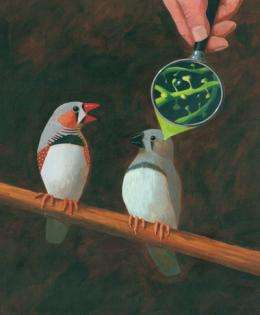Juvenile songbirds were used in a study by researchers at Duke University Medical Center and their findings provided fundamental insight into how the brain changes in juvenile male songbirds during the juvenile's critical periods for behavioral learning. Credit: Painting by John Holdway, Jr. (www.JohnHoldway.com)
When African Grey parrots talk, do they mimic sounds or consciously understand their speech? Irene Pepperberg, a comparative psychologist at both Brandeis and Harvard universities believes African Greys actually know what they’re talking about.
"They understand things like categories of color, material and shape, number concepts, and concepts of bigger and smaller, concepts of similarity and difference, and absence; things we once thought that a bird could not comprehend, these parrots are showing us it's possible," says Pepperberg.
With support from the National Science Foundation (NSF), Pepperberg studies the cognitive and communicative abilities of African Greys. She says the birds have the social skills of a 2-year-old child and the intelligence of a 5-year-old. That statement might ruffle some feathers, but in Pepperberg's lab at Brandeis University in Waltham, Mass., she's out to prove that talking with the animals isn't just the stuff of fiction.
To start, talking with these birds means simplifying language down to "motherese." Instead of asking what something is made of, Pepperberg will ask, "What matter?" And, when she asks the bird "What shape?" instead of saying "square," they say "four-corner," to clarify the relationship between shape and numbers of points on an object.
One of the things Pepperberg studies is the parrots' ability to identify partially obscured shapes.
"In the wild, we expect these birds to be able to do that because if you see part of a predator, you want to respond as if it is an entire predator," says Pepperberg.
She demonstrates this by showing a parrot a square, partially obscured by a circle, and the bird is still able to identify the shape as "four-corner."
If the parrot responds to "What shape?" by just saying "corner," Pepperberg asks "How many corners?" and the parrot responds "four." The bird doesn't get it right 100 percent of the time, but Pepperberg's data suggests they understand the concept of a square even when it is partially obscured.
When testing, Pepperberg is cautious, making sure she doesn't send subtle cues to the birds. "We have controlled for that many times," she explains. "We have different people training versus testing. We mix up different types of questions in each test session. The testing is basically blind."
Pepperberg says her research on talking with birds has benefits for humans. "A colleague has used our training techniques--a two-person modeling system--with autistic children to help them learn speech and communication skills," she says.
Pepperberg believes that despite the birds having a brain the size of a shelled walnut, their contribution to understanding language and intelligence is significant. "All of our work is trying to show people that 'birdbrain' should really be a compliment," she adds.
Provided by National Science Foundation





















